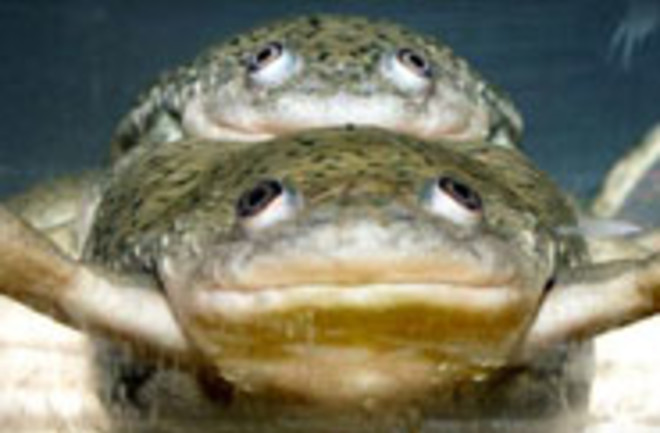Source: Common Weedkiller Chemically Castrates Frogs; Turns Males Into Females | Discover Magazine
Atrazine, one of the world’s most widely used herbicides, is wreaking havoc on the sex lives of male frogs. In a new experiment, exposure to the chemical emasculated more than half of the male African claw frogs in the study, and made one in ten turn into females. The results, which were published in the Proceedings of the National Academy of Sciences, have raised concerns that the herbicide found in waterways is altering amphibians’ hormones, and could potentially have similar effects on other animals, including humans. Biologist Tyrone Hayes studied 40 male control tadpoles along with 40 male tadpoles reared in water tainted with atrazine. The levels of the chemical matched the levels the frogs would encounter in their natural settings, and was also within the drinking water standards set by the Environmental Protection Agency. The results showed that 75 percent of male tadpoles reared in atrazine-contaminated water developed into frogs that
had low testosterone levels, decreased breeding gland size, feminized laryngeal development, suppressed mating behavior, reduced sperm production and decreased fertility, while the control group showed features typically found in male frogs [AFP].
Most of these “chemically castrated” frogs were unable to reproduce. The rest of the results were even more dramatic. Ten percent of tadpoles raised in the chemically tainted water developed into frogs with male genetics but female anatomy, and some of these were actually able to breed and produce eggs. The offspring, researchers found, were all male because both parents contributed male genes. Scientists worry that the sex-reversed males and the subsequent production of all-male offspring is skewing the sex ratio of wild frog populations, and may be contributing to the decline of frog populations worldwide. This is not the first time that Hayes has found atrazine to be wreaking havoc on male frogs. In 2002, working on the African clawed frog, the researchers found that
tadpoles raised in atrazine-contaminated water become hermaphrodites – they develop both female (ovaries) and male (testes) gonads. This occurred at atrazine levels as low as 0.1 parts per billion (ppb), 30 times lower than levels allowed in drinking water by the EPA (3 ppb) [University of California, Berkeley].
Subsequent studies in the Midwest showed that male leopard frogs living in atrazine-contaminated streams often had eggs in their testes. They also had lower testosterone levels and smaller voice boxes, which scientists presumed hampered their ability to call mates. Other studies have found that atazine can interfere with the hormones and sexual development of fish, birds, and rats. Hayes says his new
findings should raise alarms about human health. “It’s a chemical . . . that causes hormone havoc,” Hayes said. “You need to look at things that are affecting wildlife, and realize that, biologically, we’re not that different” [Washington Post].
However, Syngenta, the leading manufacturer atrazine, has disputed Hayes’ studies. Hayes responded by saying that people will have to make a final call on whether the costs of atrazine exposure outweigh its benefits: “Not every frog or every human will be affected by atrazine, but do you want to take a chance, what with all the other things that we know atrazine does, not just to humans but to rodents and frogs and fish?”
[AFP].
An estimated 80 million pounds of atrazine is used annually in the United States, and it’s commonly found in ground and surface water.
About 75% of stream water samples and 40% of groundwater samples contain atrazine, according to the U.S. Geological Survey. The Natural Resources Defense Council, an environmental advocacy group, detected atrazine in 90% of tap water samples from 139 water systems [USA Today].
The EPA is currently reviewing the herbicide, while several states are considering banning it all together. Atrazine is already banned in the European Union.

